Introduction
Social media platforms are constantly growing in popularity as a result of the established culture of interconnection and bidirectional information exchange (Van Dijck et al, 2018). Social media influencers (SMIs), in this regard, are an important part of this information network as they keep their audience up with emerging products, technology, and even current affairs. Even though advertisements are meant to be enlightening, the information offered by individual influencers is genuine and reliable. To maintain their large following, they must maintain their credibility. The audience follows an influencer because they see them as thought leaders, and they follow them as a result of their connection with the influential person (Geyser, 2021).
Social media users are increasing by 13.1% per year, adding an estimated 520 million new users. Until 2021, the world is home to 4.48 billion active social media users, representing 57% of the world’s population (Data Reportal, 2021) edifying a collective system of virtual spaces in which consumers are linked inside and through multiple interactive platforms that construct a social media ecosystem (Ham et al, 2019).
Pakistan, at the beginning of 2021, had a population of 223 million out of which 61.34 million are Internet users and they are increasing by 11 million (21%) in 2020-2021. Pakistan continues to be a social media powerhouse, being one of the largest countrywide markets for Facebook, Instagram, and YouTube in the world. In 2021, there will be 46 million social media users in Pakistan, accounting for 20.6 percent of the country’s total population. The number of social media users in Pakistan increased by 9 million (24 percent) between 2020 and 2021 (Data Reportal, 2021).
Instagram, as one of the social media platforms, is amongst the most popular social networking sites that enable its users to instantaneously post videos and photographs, as well as apply filters and modify them. Additionally, Instagram allows companies to be presented aesthetically, quickly, and readily accessed. Instagram gained 855 million users in 2019, and it is anticipated that, by 2023, it would have close to 1 billion users (Statista, 2020c). In addition, Instagram is a prominent social networking site that millennials often favor (Statista, 2020a). As a result, it changes the lives of individuals by facilitating relationships between celebrities and ordinary people. To connect, engage, and entice these prospective clients on Instagram, several organizations like to use SMIs (Gunawan and Huarng, 2015).
In addition to Instagram’s dense media environment, users may generate unique one-way para-social interactions (PSIs) using SMIs. PSIs refer to the kind of psychological interaction an audience has with artists and performers in mass media, notably on television and Internet platforms (Yilmazdogan, et al., 2021) and these PSIs are real as individuals perceive them (Hung et al., 2011). In this way, audiences may enjoy following, liking, and connecting with SMIs on Instagram, and they can choose to purchase their products or visit the destinations they visit frequently (Jin & Ryu, 2020).
One of the most recognized instances of potential interactions between individuals and media figures is para-social relationships (Oliver et al., 2019). However, since a para-social connection is an imagined one between an audience and an influencer, it has a one-sided structure and so varies from an interpersonal relationship (Sokolova and Perez, 2021). Para-social relationships occur unilaterally, non-dialectically, and in a mutually exclusive way. Indeed, social media platforms are ideal for fostering para-social interactions (Chung and Cho, 2017). PSI’s establishment of a link between media celebrities and social networks has cleared the path for academic research. PSI on social networks may so reveal online purchasing intent.
Audiences may be more inclined to visit the place in photographs posted by SMIs on Instagram. Given the large number of sites that may be visited and the competitiveness in this regard, it is vital to comprehend the aspects that might affect and shape the audiences’ visiting intentions (Dedeoglu, 2019). However, at this time, the credibility of SMIs as information sources is critical in terms of the impact of the message sent out to the consumers. At the same time, customer intentions are directly affected by source credibility (Yuan, et al., 2016). Based on the above, the objective of this study is to investigate the matter of perceived source credibility to determine the direct effect of source credibility cues (attractiveness, trustworthiness, expertise, and homophily) on the online purchase intention of millennials who buy the products and services after watching Instagram advertisement made by the SMIs.
Literature Review and Hypotheses Development
The Theory of Planned Behavior
Since the late 1970s, when Martin Fishbein and Icek Ajzen developed the theories of reasoned action (TRA) and planned behavior (TPB), and, in its more recent version, the reasoned action approach, has been among the most influential approaches to predicting and understanding intentional behavior. The ideas have been extensively used in a variety of behaviors, situations, and populations. The theory’s primary component is the intention, a motivational construct that is seen as the most proximal predictor of behavior. Intention represents how likely a person is to intend to undertake and commit effort in pursuing a specific activity. TRA is successful in predicting variability in people’s behavior over a wide range of circumstances, demographics, and activities. Ajzen extended the idea of TRA to account for actions that were not entirely within the individual’s control. Perceived behavioral control was included as an additional predictor of intents in TPB. When people’s perceptions of control closely match real control, the intensity of the intention-behavior relationship is determined by perceived behavioral control. Individuals are more likely to act on their intentions when they think they have a high level of behavioral control. Ajzen also claimed that when perceived behavioral control closely resembles real control, it may predict behavior directly. The theories’ appeal stems from their relative simplicity and flexibility, as well as their efficacy in accounting for significant variation in behavior (Hagger, 2019). This study is underpinned by the TPB since it’s a conceptual model used to explain consumer behavior, his/her intentions to make a purchase, and how several norms are formed inside the consumer’s mindset that serve as a clear reason for the consumer’s behavioral pattern. In the next section, a complete literature review of influencer marketing and social media influencers has been included.
Influencer Marketing and Social Media Influencers
Influencer marketing is a form of native advertising, where markets pay the credibility to create and publish a content format that matches the advertiser’s original content (Wojdynski & Golan, 2016). Influencer marketing is also called a type of marketing using key opinion leaders to effectively deliver an advertiser’s message to the target audience on different social media platforms (Byrne, et al., 2017).
Social media platforms are much more than a shared space for communication. They are focusing not only on the exchange of content but also on stressing the high level of involvement of social media users to create value for businesses and support the brand (AlFarraj, et al., 2021). This shared space is incomplete without social media influencers. SMIs are personalities who through their expertise and constant presence on different social media channels (such as YouTube, Instagram, and Facebook) generate huge engagement and eWoM compared to other marketing strategies (Nascimento, 2019).
SMIs who often do pay product endorsements charge higher fees from advertisers for promotional posts based on the number of their followers. However, having a huge following does not really show more influence due to the rising issue of fake followers. Although it is really fascinating to hire SMIs having followers in 7- or 8-digit numbers! But all smart marketers know that the key is to rely on engagement rather than numbers and micro-influencers simply provide that. They have a lesser number of followers, but their engagement numbers bowl over mega-influencers (Wessel, 2018).
Influencer marketing is more flexible and less invasive than traditional or online marketing. The influencer can be a teenager, a scholar, or a celebrity but the only rule to win millions is consumer trust (Conick, 2018). Influencers, whether teenagers or celebrities, develop and upload ad-supported material to their accounts, circumventing ad blockers and possibly appearing in millions of social media feeds. Because influencer marketing is a new phenomenon, the body of literature is also nascent. It works at its best when the influencer presents organic content (Kadekova & Holiencinova, 2018).
Source Credibility and Consumer Buying Intention
Source credibility in the communication field is widely used to measure audiences’ attitudes toward mass media sources. It is defined as the degree to which a communicator’s positive characteristics influence the receiver’s acceptance of information. The source credibility theory was developed to measure the effectiveness of SMIs under three characteristics and named expertise, trustworthiness, and physical attractiveness that drive the individuals’ perceptions of source credibility (Tille , 2020). Based on these three dimensions, a new dimension was developed specifically in the case of social media influencers, which is homophily that is based on the resemblance between influencers and their followers, regarding demographics, ideas, or opinions (Munnukka, et al., 2016).
The word “trustworthiness” refers to the source’s apparent integrity as well as the perceivers’ trust in the source’s capacity to offer honest and accurate assertions (Ohanian, 1990). Trustworthiness, as a key component of source credibility, has a major impact on message persuasiveness and customer purchase intention (Pornpitakpan, 2004). SMIs establish trust when their followers view them to be dependable, reliable, sound, honest, and sincere (Ceyhan, et al., 2018; Weismueller, et al., 2020). As the main dimension of source credibility, trustworthiness significantly influences the persuasiveness of a message and individuals’ evaluation of message credibility. In the context of marketing and advertising, trustworthiness positively influences consumer attitudes toward the brand and brand beliefs (Pornpitakpan, 2004).
Ohanian (1990) defines expertise as the endorser’s experience, knowledge, ability, and qualification. Expertise indicates that the individual responsible for promoting and marketing the product has the necessary knowledge, experience, and aptitude to do so. The rate at which individuals follow a source’s suggestions depends on their perceived degree of knowledge and the message’s power (Weismueller, et al., 2020). Highly reputable sources are more likely to persuade others that their message is true because of their knowledge. The competence of an endorser is analogous to a qualification that directly determines the amount of conviction required to convince customers to buy whatever is recommended (Wang & Scheinbaum, 2018). As a result, a lack of competence might lower influencers’ perceived credibility (Sokolova & Kefi, 2020). Both brand attitude and purchasing intention are positively influenced by expertise (Till & Busler, 2000). Purchase intent is positively connected to credibility, especially knowledge. Longtime followers of trustworthy influencers who care about their followers and demonstrate topic competence are more inclined to buy the advertised items (Sokolova & Kefi, 2020). Attractiveness is another feature of the source credibility model. It is considered that the more appealing the source, the more inclined the purchaser will be to buy (van der Waldt et al., 2009). Prior studies showed that how a person views another person is contingent on the other’s physical appeal and have also shown that physically beautiful individuals are typically adored by their target audience, and their message about the product is seen as more favorable (Ceyhan, et al., 2018). The attraction factor of credibility states that the message’s effectiveness increases when the audience is attracted to SMIs (Wang & Scheinbaum, 2018). The use of the physical attractiveness of SMIs as a construct to assess the influencers’ trustworthiness is becoming increasingly prevalent in the context of social media influencer marketing (AlFarraj, et al., 2021; Chetioui, et al., 2020).
Homophily refers to the resemblance between the information source and the recipient of the information transmission (Xiao, Wang, & Chan-Olmsted, 2018). The degree to which message recipients and senders are similar determines the level to which message recipients perceive the credibility of the senders. More importantly, the similarity in views between message recipients and senders has a greater impact on source trust than other sorts of similarity, such as gender or physical appearance, do (Metzger, et al., 2003). The para-social interaction is another characteristic that is hypothesized to be influenced by source credibility and that may be used to predict purchase intention in addition to source credibility. This study posits, with support from the aforementioned research and literature, that perceived source cues influence consumer purchase intention through perceived source credibility.
Para-Social Interactions (PSIs)
An audience’s psychological link with a performer in the mass media, notably on television and online, is referred to as PSIs. In contrast to interpersonal relationships, however, it has a one-sided orientation and so differentiates (Sokolova & Perez, 2021). Even though they have had no or limited encounters with media celebrities, viewers or listeners grow to see them as friends. It is characterized as an illusionary experience in which media viewers interact with personalities (e.g., talk show hosts, celebrities, fictitious characters, and influencers on social media platforms) as though they are in a reciprocal relationship with them (Zhang, et al., 2020).
PSIs are one of the most visible manifestations of the relationships and friendships between individuals and prominent media celebrities (Oliver et al., 2019). It enables social media users to communicate with well-known media influencers in the above-mentioned engagements, which they believe to be realistic, via simulated interactions (Labrecque, 2014). Since people have more regular interactions with SMIs, they have become more aware of how these people in the media behave. As a consequence, they have increased their trust in SMIs and consider their viewpoints toward particular products and services (Hartmann & Goldhoorn, 2011). The irony is that social networking sites are excellent resources for establishing para-social interactions (Chung & Cho, 2017). There is a surplus of research accessible in which researchers have attempted to assess the influence of PSIs on social media; nonetheless, it is still unclear how PSIs moderate the relationship between source credibility and purchase intention. Consequently, the goal of this study is to evaluate the moderating role of PSIs in the relationship between source credibility cues and consumer buying intention, based on the illusionary experience in which millennials interact with SMIs.
Influencer Marketing on Instagram
As corporations continue to discard conventional advertising strategies, efforts are more concentrated on these influencers to advocate their products and services among their followers and beyond. These endorsements are likely to be viewed as extremely credible electronic Word of Mouth (eWOM) rather than paid advertising since they are frequently smoothly integrated into the daily narrative influencers share on their Instagram profiles (Veirman et al., 2017). Research done by Evans, Phua, Lim, and Jun (2017) indicated that when a customer recognizes that the Instagram post is advertising, and they also recall a disclaimer in that material, there is a strong influence on attitudes and intention to promote eWOM. However, there are still problems remaining as to how one can effectively tell consumers about the nature of the influencer advertising to which they are exposed (Evans et al., 2017).
Many professionals consider the number of followers as the primary criterion when selecting influencers to deliver a message on Instagram. According to Veirman et al. (2017), having more followers significantly influences views about the influencer, most notably via increased perceptions of popularity and, to a lesser extent, because higher perceptions of popularity encourage individuals to attribute more opinion leaders to the influencer. A large number of followers may therefore contribute to a larger sense of popularity, and hence better likeability, but this does not inevitably imply that the influencer is viewed as an opinion leader. Furthermore, the data indicated the appearance of a negative association between the number of followers and likeability when a prominent influencer follows just a few accounts (Veirman et al., 2017). The number of followers is not a sufficient criterion for identifying an opinion leader. Similarly, perceived originality and distinctiveness play an important role in building opinion leadership on Instagram, which impacts customer behavioral intentions. This impact grows when the customer believes the information uploaded to the account is relevant to his or her personality and interests.
Hypothesis Development
The purpose of this research is to analyze perceived source credibility cues to ascertain the direct influence of source credibility cues on the online buying intention of Instagram users. The study’s secondary objective is to determine the moderating effect of PSIs on the link between source credibility and consumer buying intention. Following are the three preliminary hypotheses, created for this study.
H1: The source credibility (H1a Attractiveness, H1b Expertise, H1c Trustworthiness, and H1d Homophily) of social media influencers has a positive impact on the Consumers’ buying intention when it comes to online shopping.
H2: Consumers’ buying intention is significantly influenced by the para-social interactions developed by Millennials and SMIs while they are using Instagram.
H3: Para-social interactions moderates the relationship between the source credibility cues of social media influencers and Consumers’ buying intention.
Methodology
Target Population and Sampling Technique
The target population of the study is composed of millennials who are living in the city of Lahore, Islamabad, and Karachi. The rationale for selecting these cities is that they are multi-ethnic, have the highest concentration of Pakistani population, and have the highest number of Instagram users. Millennials (Aged: 26-41 Years, born from 1981-1996) were chosen for this study because they are expected to use technology more regularly. Moreover, Instagram is the most popular social media network, with around 80 percent of Instagram users being millennials (Statista, 2020a).
Sample Size and Data Analysis Tool
The Structural Equation Modelling (SEM) approach was used in this study to develop an integrated model for the investigation and to evaluate the hypothesis. The sample size for this research was 400 millennials, which was determined by taking into account the SEM sample size constraints and Ruane’s (2005) criteria.
Questionnaires Design and Measurement Scale
Questionnaires were distributed among millennials through various social media platforms for data collection, and the online survey software Question-Pro was employed for online data collection. The online source credibility scale is adapted from the study of Xiao, Wang, and Chan-Olmsted (2018). PSIs are adopted from the study of Yılmazdogan, et al. (2021), the consumer buying intention scale is adapted from Mahmood, et., al. (2022), while the demographic scale (Table-1) is adapted from Aggad, et.al., (2021) and Mahmood & Baharun (2021). Several items were added and modified to fit the findings within the context of influencers. The data were obtained using a five-point Likert scale and SPSS was used for preliminary data analysis.
Preliminary Test
To analyze the data for distribution characteristics, this study performed MCAR statistics, skewness, and kurtosis along with Shapiro-Wilk tests. This study’s outcomes demonstrated that insignificant MCAR statistic (Chi-Square = 391.477; df =456; Sig = 0.981) revealed that missing values (07) was random, Harman’s single factor test which described that 43.1 percent of the variance, the Skewness, Kurtosis values (-1.96 and +1.96), and Shapiro Wilk test (>0.05) for most latent variables. The verdicts revealed that the data collected for this study were normally distributed.
Results
After data screening and exploratory analyses yielded a sufficient dataset (N=400) for this research, the data were analyzed using PLS-SEM to evaluate the hypotheses. Using Smart-PLS to perform a confirmatory factor analysis (CFA), all items with a threshold less than 0.70 were eliminated, and the constructs’ reliability, convergent validity, and discriminant validity were evaluated.
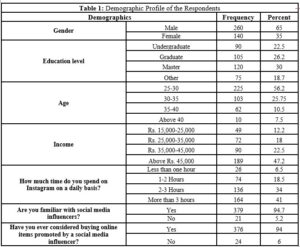
The Measurement Model
After eliminating items, a second CFA was conducted using the remained items, and the majority of latent variables’ reliability was within the indicated limit. To comprehend the characteristics of survey respondents, demographic information is provided (Table 1). The convergent validity of components was determined by composite reliability (CR) and the extracted mean-variance (AVE). The findings indicated that both CR and AVE values are above the cut-off values, where CR values range from 0.918-0.938, and AVE values range from 0.669-0.771. All three accessible criteria were used to evaluate the measurement model’s discriminant validity.
Heterotrait-Monotrait Ratio of Correlations (HTMT) Criterion: As a lenient threshold, it is suggested that the correlation coefficients of latent variables should fall below 0.90. In this study, the greatest correlation value between latent variables was 0.757, which is near to HTMT cutoff value (Table 3).
Cross-loading Criterion: In the cross-loading criteria, all measurement items were loaded relatively highly to their respective latent variable than to any other variable.
Assessing the Validity of the 2nd Order Construct: Source Credibility Cues were assessed as second-order constructs in the present study (reflective-reflective in nature). The validity and reliability of second-order constructs were
assessed similarly to first-order constructs. The findings demonstrated that convergent validity, and discriminant validity at second order through (i) HTMT (0.85) and (ii) Fornell and Larcker met the aforementioned requirements.
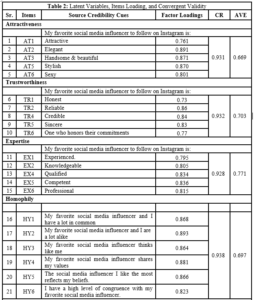
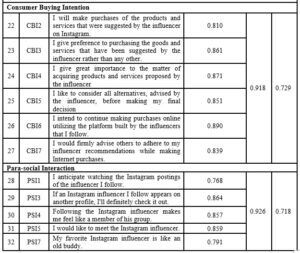
Fornell and Larcker Criterion: Comparing AVE’s square root (bold values in Table 3) with squared correlation coefficients (other values) between each pair of components demonstrated discriminant validity. AVE values were higher than the squared correlation coefficients of comparable rows and columns between the constructs, as shown by the findings.
The Structural Model
Before evaluating the model’s explanatory power, the importance of the path coefficient, including moderator analysis, the goodness of fit, predictive relevance, and effect size, the structural model might be evaluated for collinearity concerns using the VIF values (Hair et al., 2016).
Collinearity Assessment through VIF: The study revealed that VIF values (Table-4) for all exogenous constructs (SCC=1.213, PSI=2.896) stayed below the threshold value (Hair et al., 2016), indicating that the model did not have any collinearity concerns and was eligible for further evaluation.
The explanatory Power of the Model (f 2) and Predictive Relevance (Q2): With statistically significant t-values (Table 4) and p-values at a 99% confidence range, the endogenous construct CBI explains 56.1% of SCC and PSI (exogenous variables) (Hair et al., 2016). Consequently, the findings suggested that the model is parsimonious since the R2 values for the endogenous construct met the minimal cutoff criteria. This research included a single endogenous construct (CBI) with Q2 values of 0.457 (Table 4).
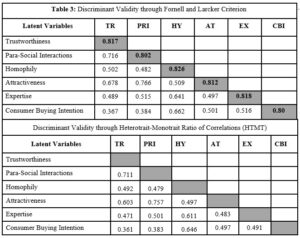
All endogenous construct values were considerably above the threshold, indicating that the reliability coefficient of the structural model was good (Hair et al., 2016).
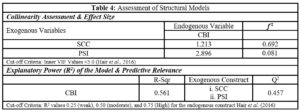
The significance of path coefficient (β) and Model Fit: Table-5 illustrates that the impact of SCC on CBI was statistically significant (b=0.437; t=4.981; p=0.000), supporting hypothesis H1. H1 was further categorized into four parts to assess the individual influence of SCC on the CBI. The result revealed that H1a: Attractiveness (b=0.912; t=12.365; p=0.000), H1b: Expertise (b=0.907; t=11.234; p=0.000), H1c: Trustworthiness (b=0.887; t=10.056; p=0.000), and H1d: Homophily (b=0.834; t=10.056; p=0.000) has a significant effect on consumer buying intention. Hypothesis H2 stated that PSI had a significant influence on CBI, which was validated by the findings of the research (b=0.638; t=16.411; p=0.000). H3 postulated that PSIs influence the relationship between SCC and CBI while buying things online (b=0.181; t=2.678; p=0.000). The SRMR and NFI match the requirements for model fit (Table 6), and the original values of indices are smaller than the upper limit of the confidence interval of 99 percent, which indicates a satisfactory model fit. This research adhered to the recommendations of Hair et al. (2016).
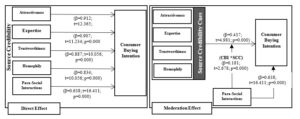
Figure 1: Path Diagram
Moderation Treatment: In this study, a two-stage approach for the creation of the interaction term. The two-stage approach is highly recommended and versatile and should generally be given preference for creating the interaction term (Hair et al., 2016).
Stage-1: First part of the model (without moderation) there is only an arrow linking source creditability cues (Y1) on consumer buying intention (Y2), the effect P1 (β=0.431; t-value=0.396; and p-value=.000) is referred to as a direct effect or the main effect have a strong relationship between the exogenous and endogenous constructs.
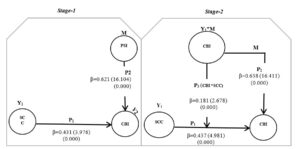
Figure 2: Moderating Modelling by Using Two Stage Approach
Stage-2: Results indicated that the source creditability cues (Y1) and consumer’s buying intention (Y2) are moderated by para-social interactions M (β=0.181; t-value=2.678; p-value=0.000). Meanwhile, source creditability cues (Y1) effect on consumer buying intention (Y2), in simple effect P1 (β=0.437; t-value=4.981; and p-value=0.000), has been increased due to third construct effect that is para-social interactions (M). This research also reflects the moderating modeling suggestions made by Henseler and Fassott (2010), which stipulated that if the level of the moderator variable is raised, the simple impact P1 is predicted to vary by the amount of P3 (See Figure 2).
Discussion and Conclusion
The main focus of this study was to explore how source credibility cues influence individuals’ evaluation of the credibility of information provided by Instagram influencers. Using source credibility theory as a guide, this study sought to establish if SCC and PSIs had an impact on CBI while shopping online. The findings of the study also aligned with the former literature related to the constructs of the study.
The study’s measurement and structural models demonstrated that source credibility cues which include attractiveness, expertise, trustworthiness, and homophily were significant in the interaction of social media influencers with millennials particularly when they evaluate the credibility of contents in the information processing model. The finding reveals that SCC significantly influences the millennials’ buying intention while purchasing online (Figure 1). The use of social media influencers to promote online shopping should be looked at from a rational point of view. This study shows that millennials used to follow social media personas on Instagram, and they think they give them clear information about different products that helps them choose a trustworthy brand. Aligned with many other studies (Ceyhan, et al., 2018; Metzger, et al., 2003, Weismueller, et al., 2020) that investigate source credibility as a general construct under the guidance of the source credibility theory, the result of this study revealed that social media influencers enhance the interaction of young followers and empower them to discover more about specific brands while posting content, images, or videos (Chetioui, et al., 2020).
There is a direct effect of SCC on the online purchase intention of millennials who buy goods and services after seeing Instagram commercials generated by SMIs are shown in Figure 1. SCC dimensions of attractiveness, trustworthiness, expertise, and homophily had a direct influence on millennial purchase intention. According to the research in the relevant literature, each facet of source trustworthiness positively impacted purchase intention (Ceyhan, et al., 2018; Xiao, et.al., 2018; Wang & Scheinbaum, 2018; Weismueller, et al., 2020).
The findings revealed that para-social interactions with social media influencers also have a significant influence on millennials’ buying intention particularly when they opt to purchase the products online. Findings further elaborate that the millennials believed that they look forward to seeing the posts of the influencer they follow on Instagram (Hung et al., 2011; Jin and Ryu, 2020). They would like to personally meet the Instagram influencer and feel like part of his/her team. They further asserted that the way Instagram influencer shares things on his/her account makes them feel as comfortable as if they are with their family and friends (Gunawan & Huarng, 2015; Yılmazdogan, et al., 2021).
The moderating role of para-social interactions was measured with the effect of source credibility cues and consumer buying intentions. According to the study’s findings, PSI plays a significant moderating function in the influence of source credibility cues and consumer buying intention. In other words, if an Instagram influencer is trustworthy, experienced, and knowledgeable about their field, the PSI built with the influencer has a moderating effect on the establishment of a purchasing intention by Instagram users who follow that Instagram influencer.
Future Research Directions
The conclusions of this research are useful for SMIs who wish to establish more remarkable strategies for developing and distributing content, as well as collaborate with brands in this area. SMIs’ recommended products are more likely to be liked by their followers because they are honest and knowledgeable in their profession, and they can communicate socially with their followers. They may influence their followers’ brand selections to attract millennials who are strongly interested in Instagram. SMIs should specialize in their professions and place a premium on credibility to communicate with their followers and allow them to purchase things online. Similarly, managers who are targeting millennials should collaborate with SMIs that provide constant, dependable, and honest sharing to achieve a competitive edge.
References
- Aggad, K. K., Ahmad, F. S., & Kamarudin, S. (2021). Research Article Investigating the Impact of Influencers’, Characteristics, Contents, and Trustworthiness on Consumers’ Purchase Intention. Review of International Geographical Education Online, 11(6), 885-902.
- Anand, A., Dutta, S., & Mukherjee, P. (2020). Influencer Marketing with Fake Followers. (pp. 1-45). Bangalore: Chicago Booth-India Quantitative Marketing Conference.
- Byrne, E., Kearney, J., & MacEvilly, C. (2017). The Role of Influencer Marketing and Social Influencers in Public Health. Proceedings of the Nutrition Society. Irland: Irish Section Meeting.
- Ceyhan, S., Dogan, I. C., Yildiz, M., & Barca, M. (2018). Boundary conditions for the emergence of relational trust among exporters and importers. Review of International Business and Strategy, 28(3/4), 358-372.
- Conick, H. (2018, December 8). How to Win Friends and Influence Millions: The Rules of Influencer Marketing. American Marketing Association.
- Chetioui, Y., Benlafqih, H., & Lebdaoui, H. (2020). How fashion influencers contribute to consumers’ purchase intention. Journal of Fashion Marketing and Management: An International Journal.
- Chung, S., & Cho, H. (2017). Fostering parasocial relationships with celebrities on social media: Implications for celebrity endorsement. Psychology & Marketing, 34(4), 481-495.
- Data Reportal (2021). Digital 2021: Pakistan. Retrieved from: https://datareportal.com/reports/digital-2021-pakistan
- Dedeoglu BB (2019). Are information quality and source credibility really important for shared content on social media? International Journal of Contemporary Hospitality Management 31(1): 513–534.
- Evans, N. J., Phua, J., Lim, J., & Jun, H. (2017). Disclosing Instagram influencer advertising: The effects of disclosure language on advertising recognition, attitudes, and behavioral intent. Journal of interactive advertising, 17(2), 138-149.
- Geyser, W. (2021). Influencer Marketing Hub. Retrieved from www.influencermarketinghub.com: https://influencermarketinghub.com/author/werner-geyser/
- Gunawan, D. D., & Huarng, K. H. (2015). Viral effects of social network and media on consumers’ purchase intention. Journal of Business Research, 68(11), 2237-2241.
- Hagger, M. S. (2019). The reasoned action approach and the theories of reasoned action and planned behavior.
- Hair Jr, J. F., Sarstedt, M., Matthews, L. M., & Ringle, C. M. (2016). Identifying and treating unobserved heterogeneity with FIMIX-PLS: part I–method. European Business Review.
- Ham, C. D., Lee, J., Hayes, J. L., & Bae, Y. H. (2019). Exploring sharing behaviors across social media platforms. International Journal of Market Research, 61(2), 157-177.
- Hartmann, T., & Goldhoorn, C. (2011). Horton and Wohl revisited: Exploring viewers’ experience of parasocial interaction. Journal of communication, 61(6), 1104-1121.
- Henseler, J., & Fassott, G. (2010). Testing moderating effects in PLS path models: An illustration of available procedures. In Handbook of partial least squares(pp. 713-735). Springer, Berlin, Heidelberg.
- Hung K, Chan KW and Tse CH (2011) Assessing celebrity endorsement effects in China. Journal of Advertising Research 51(4): 608–623.
- Jin, S. V., & Ryu, E. (2020). “I’ll buy what she’s# wearing”: The roles of envy toward and parasocial interaction with influencers in Instagram celebrity-based brand endorsement and social commerce. Journal of Retailing and Consumer Services, 55, 102121.
- Kadekova, Z., & Holiencinova, (2018). Influencer Marketing. Communication Today, 9(2), 90-104.
- Labrecque, L. I. (2014). Fostering consumer–brand relationships in social media environments: The role of parasocial interaction. Journal of interactive marketing, 28(2), 134-148.
- Mahmood, C. K., Ahmad, S., Khalil, T., Ali, H., & Sarfaraz, T. (2022). Does Product Related Knowledge and Non-Functional Cues Matter for Financial Decisions: Consumer Perception towards Islamic Banking of Pakistan.
- Mahmood, C. K., Baharun, R., & Khalil, T. (2021). Country of origin effects in financial service evaluation: the pakistani consumers’ perception towards foreign islamic banks. International Journal of Management (IJM), 12(2).
- Metzger, M. J., Flanagin, A. J., & Zwarun, L. (2003). College student Web use, perceptions of information credibility, and verification behavior. Computers & Education, 41(3), 271-290.
- Munnukka , J., Uusitalo, O., & Toivonen, H. (2016). Credibility of a peer endorser and advertising effectiveness. Journal of Consumer Marketing, 33((3)), 182-192.
- Nascimento, J. (2019). Understanding the role of influencers’credibility in social media and its impact onconsumers’ purchase intentions. Universidade Católica Portuguesa.
- Ohanian, R. (1990). Construction and validation of a scale to measure celebrity endorsers’ perceived expertise, trustworthiness, and attractiveness. Journal of advertising, 19(3), 39-52.
- Oliver, M. B., Bilandzic, H., Cohen, J., Ferchaud, A., Shade, D. D., Bailey, E. J., & Yang, C. (2019). A penchant for the immoral: Implications of parasocial interaction, perceived complicity, and identification on liking of anti-heroes. Human Communication Research, 45(2), 169-201.
- Pornpitakpan, C. (2004). The persuasiveness of source credibility: A critical review of five decades’ evidence. Journal of applied social psychology, 34(2), 243-281.
- Sokolova, K., & Perez, C. (2021). You follow fitness influencers on YouTube. But do you actually exercise? How parasocial relationships, and watching fitness influencers, relate to intentions to exercise. Journal of Retailing and Consumer Services, 58, 102276.
- Statista (2020c). Digital Market Outlook. Retrieved from: https://www.statista.com/outlook/dmo/digital-advertising/social-media-advertising/worldwide
- Till, B. D., & Busler, M. (2000). The match-up hypothesis: Physical attractiveness, expertise, and the role of fit on brand attitude, purchase intent and brand beliefs. Journal of advertising, 29(3), 1-13.
- Van Der Waldt, D.L.R. M Van Loggerenberg & L. Wehmeyer (2009). Celebrity Endorsements versus Created Spokesperson in Advertising: A Survey Among Students. South, African Journal of Economic and Management Sciences, 12(1), 100-114.
- Van Dijck, J., Poell, T., & De Waal, M. (2018). The platform society: Public values in a connective world. Oxford University Press.
- De Veirman, M., Cauberghe, V., & Hudders, L. (2017). Marketing through Instagram influencers: the impact of number of followers and product divergence on brand attitude. International journal of advertising, 36(5), 798-828.
- Wang, S. W., & Scheinbaum, A. C. (2018). Enhancing brand credibility via celebrity endorsement: Trustworthiness trumps attractiveness and expertise. Journal of Advertising Research, 58(1), 16-32.
- Weismueller, J., Harrigan, P., Wang, S., & Soutar, G. N. (2020). Influencer endorsements: How advertising disclosure and source credibility affect consumer purchase intention on social media. Australasian marketing journal, 28(4), 160-170.
- Xiao, M., Wang, R., & Chan-Olmsted, S. (2018). Factors affecting YouTube influencer marketing credibility: a heuristic-systematic model. Journal of media business studies, 15(3), 188-213.
- Xiao, M., Wang, R., & Chan-Olmsted, S. (2018). Factors affecting YouTube influencer marketing credibility: a heuristic-systematic model. Journal of media business studies, 15(3), 188-213.
- Yılmazdoğan, O. C., Doğan, R. Ş., & Altıntaş, E. (2021). The impact of the source credibility of Instagram influencers on travel intention: The mediating role of parasocial interaction. Journal of Vacation Marketing, 27(3), 299-313.
- Yuan CL, Kim J and Kim SJ (2016) Parasocial relationship effects on customer equity in the social media context. Journal of Business Research 69(9): 3795–3803.
- Zhang, Z., Gao, Y., & Li, Z. (2020). Consensus reaching for social network group decision making by considering leadership and bounded confidence. Knowledge-Based Systems, 204, 106240.









